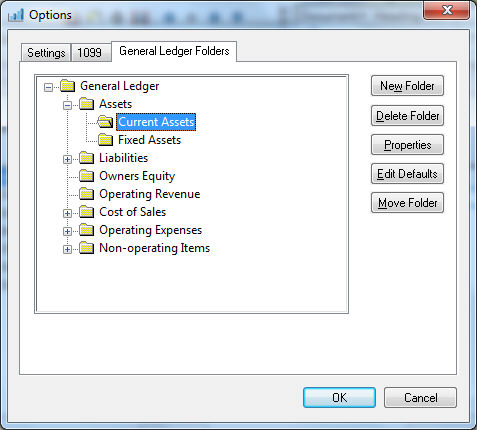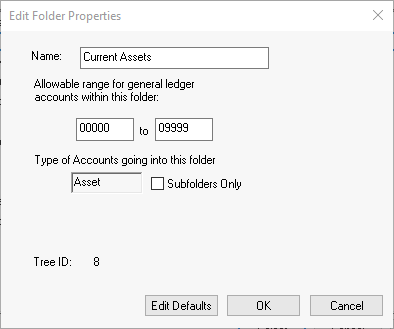Chart of Account Folders
EBMS has folders for each different type of general ledger account in the Chart of Accounts. The default folders are Assets, Liabilities, Equity, Revenue, Cost of Sales, Expenses, and Miscellaneous. Some of these folders have subfolders under them. Assets and Liabilities have both short-term and long-term subfolders. Cost of Sales has Purchases, Inventory Variance, and Other Cost of Sales. Expenses has itemized folders under it for expense types like maintenance, taxes, wages, etc. Miscellaneous has folders for both Miscellaneous Income and Miscellaneous Expense. Folders can be added, changed, and deleted as needed by your company.
Editing or Viewing Account Folders
These general ledger folders and subfolders can be edited or viewed by going to the Financials > Options > General Ledger Categories tab. The following window will appear:
Clicking the Properties button on the General Ledger Categories tab will open a window called Edit Folder Properties, where you will be able to view or edit the Chart of Account folder settings: 
-
The folder Name field can be edited using the first entry field. Note that this folder name is used in the financial statements. It is important to name general ledger folders in a clear way, so your accountant will understand what type of accounts each folder covers.
-
Allowable range for general ledger accounts within this folder. Typing in a beginning and ending account range places a limit to the account codes that can be used within this folder. This feature assists the administrator in organizing the ledger accounts in a proper manner.
-
Type of accounts going into this folder field cannot be changed after it is initially created. To change this setting, the folder needs to be deleted and recreated.
-
The Subfolders Only switch restricts accounts within certain folders. For example, since all assets are short-term or long-term, all asset accounts should be placed in a short-term or a long-term subfolder and should not be placed in the assets folder, which is the parent folder for assets. To accomplish this, the parent folder's Subfolders Only switch should be checked ON and the short- and long-term subfolders' switches should be unchecked. This will make sure there are no accounts outside of the subfolders.
-
The Tree ID value is used to query or identify the folder. Review Technical > Set Query Options for instructions to query records based on category or folder.
Click OK to save or Cancel to leave without making any changes.
Review Features > Folder Groups for more details on the Add Folder and Delete Folder buttons and folder management.
It is recommended that you set up the defaults in the Chart of Accounts window by clicking on the Edit Defaults button. Most of the fields in the General tab cannot be changed but it is recommended that you review the following defaults in the Advanced tab:
-
Retained Earnings Account: This very important setting is only applicable in Revenue or Expense folders. If any other folder is chosen, this field will be disabled and can be ignored. If this field can be edited, make sure that the proper Retained Earnings Account is entered. If your company has only one retained earnings account, which is very common, then all Revenue and Expense folders should be set to that single account. Review Retained Earnings and Other Equity Accounts section for more information on the Retained Earnings classification.
-
(Optional step) Select the Classification associated with the Advanced tab - this will set a classification associated with all the accounts in that folder. The folder and subfolder names are displayed at the top of the window (for example, General Ledger\Assets\Current Assets) and the folder name will be displayed above the tabs. If most of the accounts will be of the same classification, choose that classification for the folder, but the normal case will be that classifications will change on an account basis and should be assigned at an account level rather than by folders. This is discussed in the article on Account Classification.
Properly creating folders is an excellent method to create safeguards within the general ledger system. The user is prompted numerous places throughout the different modules in EBMS to specify a certain class of general ledger account. When the general ledger is configured correctly, only accounts of the proper type will be accepted. If a liability account has been specified, a liability account must be used in that setting. A user cannot put an equity account in place of a liability account or vice versa. Please note that you must have passwords properly established to allow or disallow people into the area where these changes can be made.